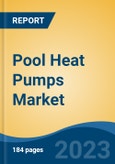Speak directly to the analyst to clarify any post sales queries you may have.
10% Free customizationThis report comes with 10% free customization, enabling you to add data that meets your specific business needs.
Key Market Drivers
Increasing Popularity of Swimming Pools for Recreation and Wellness
One of the foremost drivers fueling the growth of the global pool heat pumps market is the rising popularity of swimming pools as recreational and wellness facilities. Swimming has long been recognized as a low-impact, full-body exercise beneficial for physical fitness, mental health, and rehabilitation. This growing awareness has led to an increasing number of residential households, hotels, resorts, fitness centers, and rehabilitation clinics installing pools to attract users and clients. According to the Pool & Hot Tub Alliance, the number of residential pools in the U.S. alone grew by over 4% annually from 2020 to 2024, reflecting rising consumer interest. To maximize usability, especially in cooler climates or during off-season months, maintaining comfortable water temperatures is essential.Pool heat pumps provide an energy-efficient solution for heating swimming pools, enabling extended use regardless of outdoor weather conditions. Unlike traditional gas heaters, pool heat pumps extract ambient heat from the surrounding air, making them more sustainable and cost-effective over the long term. This is particularly attractive in regions with seasonal temperature fluctuations, where owners seek to enjoy their pools year-round without incurring exorbitant energy costs. Consequently, the expanding base of pool installations directly increases demand for reliable, efficient heating technologies like pool heat pumps.
Key Market Challenges
High Initial Investment and Installation Costs
One of the primary challenges limiting the widespread adoption of pool heat pumps is their relatively high upfront cost. Compared to conventional pool heating options such as gas heaters or electric resistance heaters, pool heat pumps require a significant initial investment for purchasing the equipment and professional installation. This high capital expenditure can deter residential pool owners, especially in price-sensitive markets or regions with lower disposable incomes.Additionally, installation complexity can add to costs, particularly when retrofitting heat pumps into existing pool systems. Proper sizing and positioning are critical to ensure optimal performance, which often necessitates the involvement of specialized technicians. In some cases, infrastructure modifications such as upgrading electrical systems or adding mounting structures can further increase expenses.
Key Market Trends
Adoption of Eco-Friendly Refrigerants and Sustainable Designs
Environmental sustainability continues to be a dominant theme in the pool heat pumps market. Regulatory pressures and consumer demand for greener solutions are driving manufacturers to adopt eco-friendly refrigerants with lower global warming potential (GWP) and ozone depletion potential (ODP). Traditional refrigerants such as R-22 are being phased out and replaced with alternatives like R-32, R-410A, and newer natural refrigerants that reduce environmental impact. According to the United Nations Environment Programme (UNEP), the Kigali Amendment aims to reduce the consumption and production of HFCs by more than 80% over the next 30 years, significantly impacting refrigerant choices globally.Alongside refrigerant changes, sustainable design principles are influencing product development. Energy-efficient compressors, enhanced heat exchangers, and improved insulation reduce energy consumption and emissions. Some manufacturers also emphasize recyclable materials and modular designs to extend product lifecycle and reduce waste.
Key Market Players
- AquaPro Systems
- Dantherm AS
- Elecro Engineering Ltd.
- G&F Manufacturing
- Hayward Industries Inc.
- Pahlen AB
- Pentair Plc
- Rheem Manufacturing Co.
- Team Horner Group
- Thermeau Industries inc.
Report Scope:
In this report, the Global Pool Heat Pumps Market has been segmented into the following categories, in addition to the industry trends which have also been detailed below:Pool Heat Pumps Market, By Type:
- Air Source
- Water/Geothermal Source
Pool Heat Pumps Market, By Capacity:
- Less than 20kW
- 10kW - 20kW
- more than 10kW
Pool Heat Pumps Market, By End User:
- Residential
- Commercial
Pool Heat Pumps Market, By Region:
- North America
- United States
- Canada
- Mexico
- Europe
- France
- United Kingdom
- Italy
- Germany
- Spain
- Asia-Pacific
- China
- Japan
- India
- South Korea
- Indonesia
- South America
- Argentina
- Colombia
- Brazil
- Middle East & Africa
- South Africa
- Saudi Arabia
- UAE
- Turkey
Competitive Landscape
Company Profiles: Detailed analysis of the major companies present in the Global Pool Heat Pumps Market.Available Customizations:
With the given market data, the publisher offers customizations according to a company's specific needs. The following customization options are available for the report.Company Information
- Detailed analysis and profiling of additional market players (up to five).
This product will be delivered within 1-3 business days.
Table of Contents
Companies Mentioned
- AquaPro Systems
- Dantherm AS
- Elecro Engineering Ltd.
- G&F Manufacturing
- Hayward Industries Inc.
- Pahlen AB
- Pentair Plc
- Rheem Manufacturing Co.
- Team Horner Group
- Thermeau Industries inc.
Table Information
| Report Attribute | Details |
|---|---|
| No. of Pages | 180 |
| Published | September 2025 |
| Forecast Period | 2024 - 2030 |
| Estimated Market Value ( USD | $ 2.28 Billion |
| Forecasted Market Value ( USD | $ 3.13 Billion |
| Compound Annual Growth Rate | 5.4% |
| Regions Covered | Global |
| No. of Companies Mentioned | 10 |









